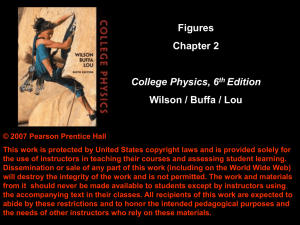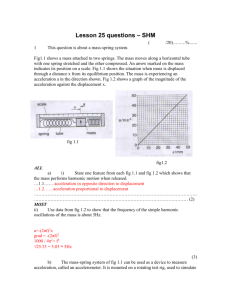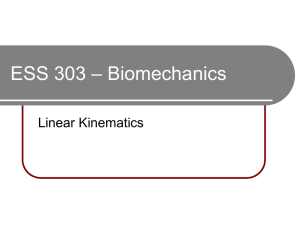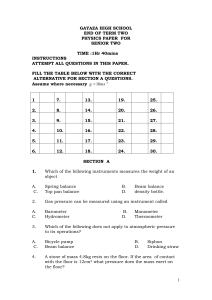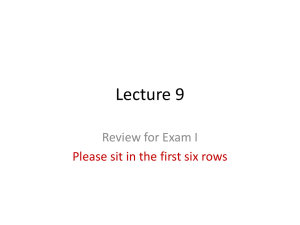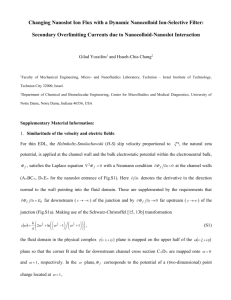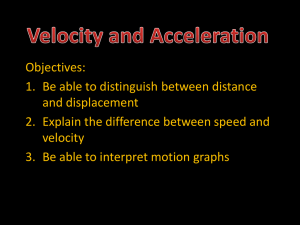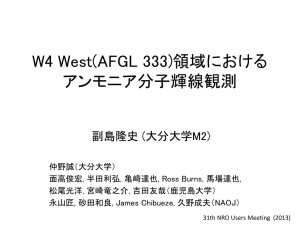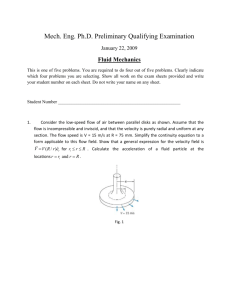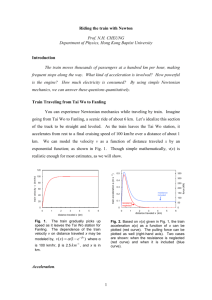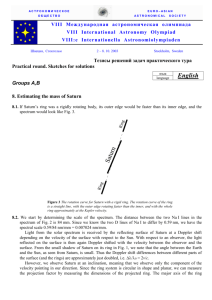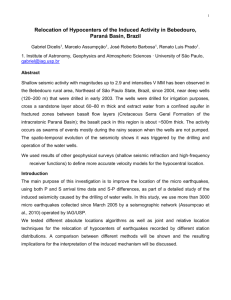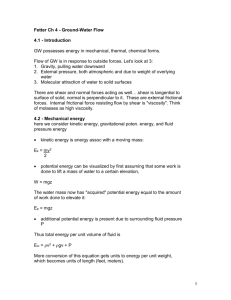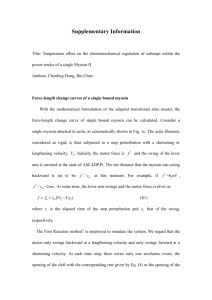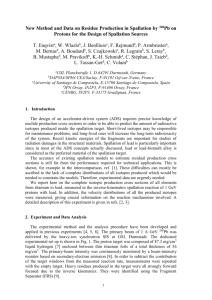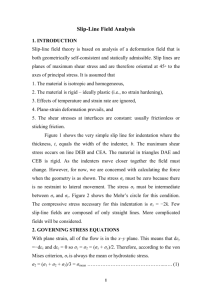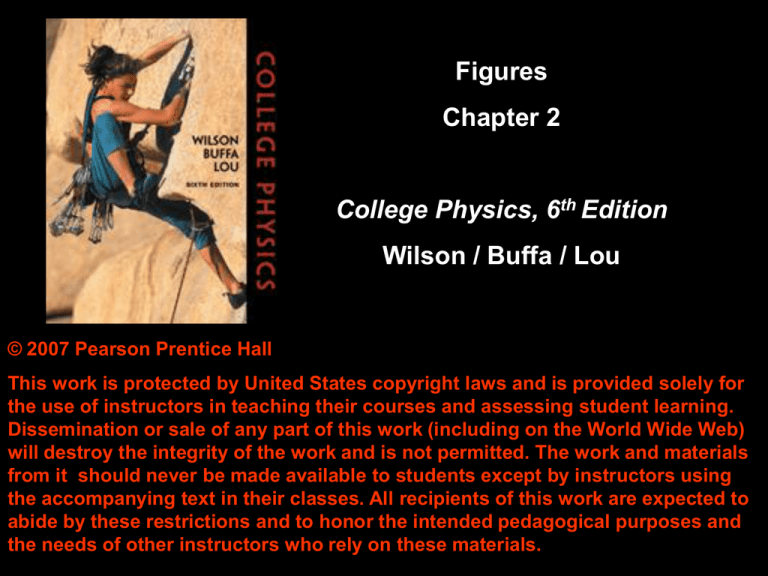
Figures
Chapter 2
College Physics, 6th Edition
Wilson / Buffa / Lou
© 2007 Pearson Prentice Hall
This work is protected by United States copyright laws and is provided solely for
the use of instructors in teaching their courses and assessing student learning.
Dissemination or sale of any part of this work (including on the World Wide Web)
will destroy the integrity of the work and is not permitted. The work and materials
from it should never be made available to students except by instructors using
the accompanying text in their classes. All recipients of this work are expected to
abide by these restrictions and to honor the intended pedagogical purposes and
the needs of other instructors who rely on these materials.
Figure 2-1
Distance – total path length
Figure 2-4
Distance (scalar) and displacement (vector)
Learn by Drawing 2-1
Cartesian Coordinates and OneDimensional Displacement
Figure 2-6
Uniform linear motion –
constant velocity
Figure 2-7
Position-versus-time graph for an object in uniform motion in the
negative x-direction
Figure 2-8
Position-versus-time graph for an object in
nonuniform linear motion
Figure 2-9
Acceleration – the time rate of change of velocity
Learn by Drawing 2-2
Signs of Velocity and
Acceleration
Figure 2-10
Velocity-versus-time graphs for motions with constant
accelerations
Figure 2-11
Away they go!
Figure 2-12
Vehicle stopping distance
Figure 2-13
v-versus-t graphs, one more time
Figure 2-14
Free fall and air resistance
Figure 2-16
Free fall up and down
(b)
Figure 2-17
Speed versus velocity
21. An insect crawls along the edge of a
rectangular swimming pool of length 27 m
and width 21 m ( Fig. 2.17). If it crawls from
corner A to corner B in 30 min, (a) what is its
average speed, and (b) what is the
magnitude of its average velocity?
(a) 2.7 cm/s (b) 1.9 cm/s
Figure 2-18
Position versus time
24. A plot of position
versus time is shown
in Fig. 2.18 for an
object in linear motion.
(a) What are the
average velocities for
the segments AB, BC,
CD, DE, EF, FG, and
BG? (b) State whether
the motion is uniform
or nonuniform in each
case. (c) What is the
instantaneous velocity
at point D?
Figure 2-19
Position versus time
25
In demonstrating a dance step, a person moves in one dimension, as shown in Fig. 2.19. What are (a) the average
speed and (b) the average velocity for each phase of the motion? (c) What are the instantaneous velocities at
t 1.0 s, 2.5 s, 4.5 s, and 6.0 s? (d) What is the average velocity for the interval between t 4.5s and t 9.0s?
[Hint: Recall that the overall displacement is the displacement between the starting point and the ending point.]
Figure 2-20
When and where do they meet?
30. Two runners approaching each other on a straight track have constant speeds of
and respectively, when they are 100 m apart (Fig. 2.20). How long will it take for the
runners to meet, and at what position will they meet if they maintain these
speeds? 12.5 s, 56.3 m (relative to runner on left)
Figure 2-21
Description of motion
38. Describe the motions of the two objects that have the
velocity-versus-time plots shown in Fig. 2.21.
Figure 2-22
Velocity versus time
50. What is the acceleration for each graph segment in Fig. 2.22? Describe the
motion of the object over the total time interval.
Figure 2-23
Velocity versus time
51. Figure 2.23 shows a plot of
velocity versus time for an
object in linear motion. (a)
Compute the acceleration for
each phase of motion. (b)
Describe how the object moves
during the last time segment.
Figure 2-24
Hit the professor
104. In Fig. 2.24, a student at a window
on the second floor of a dorm sees his
math professor walking on the sidewalk
beside the building. He drops a water
balloon from 18.0 m above the ground
when the professor is 1.00 m from the
point directly beneath the window. If the
professor is 170 cm tall and walks at a
rate of does the balloon hit her? If not,
how close does it come?
hits 14 cm in front of the professor
Figure 2-25
From where did it come?
107 It takes 0.210 s for a dropped object to
pass a window that is 1.35 m tall. From
what height above the top of the window
was the object released? (See Fig.
2.25.)
1.49 m above the top of the window
Figure 2-26
A tie race
111 A car and a motorcycle start from rest at the same time on a straight track, but
the motorcycle is 25.0 m behind the car ( Fig. 2.26). The car accelerates at a
uniform rate of 3.70 m/s2 and the motorcycle at a uniform rate of (a) How much time
elapses before the motorcycle overtakes the car? (b) How far will each have traveled
during that time? (c) How far ahead of the car will the motorcycle be 2.00 s later?
(Both vehicles are still accelerating.) (a) 8.45 s (b) (c) 13 m
Figure 2-28
Down she comes
117 Let’s investigate a possible vertical landing on Mars that
includes two segments: free fall followed by a parachute
deployment. Assume the probe is close to the surface, so the
Martian acceleration due to gravity is constant at Suppose
the lander is initially moving vertically downward at at a
height of above the surface. Neglect air resistance during the
free-fall phase. Assume it first free-falls for (The parachutes
don’t open until it is from the surface. See Fig. 2.28.) (a)
Determine the lander’s speed at the end of the 8000-m freefall drop. (b) At above the surface, the parachute deploys and
the lander immediately begins to slow. If it can survive hitting
the surface at up to determine the minimum constant
deceleration needed during this phase. (c) What is the total
time taken to land from the original height of 20000 m?
(a) -297 m/s (b) 3.66 m/s2 (c) 108 s

